
Retroactive continuity, or retcon for short, is a literary device in which established diegetic facts in the plot of a fictional work are adjusted, ignored, supplemented, or contradicted by a subsequently published work which recontextualizes or breaks continuity with the former.

Star Trek IV: The Voyage Home is a 1986 American science fiction film directed by Leonard Nimoy and based on the television series Star Trek. It is the fourth feature installment in the Star Trek franchise, and is a sequel to Star Trek III: The Search for Spock (1984); it completes the story arc begun in Star Trek II: The Wrath of Khan (1982) and continued in The Search for Spock. Intent on returning home to Earth to face trial for their actions in the previous film, the former crew of the USS Enterprise finds the planet in grave danger from an alien probe attempting to contact now-extinct humpback whales. The crew travel to Earth's past to find whales who can answer the probe's call.
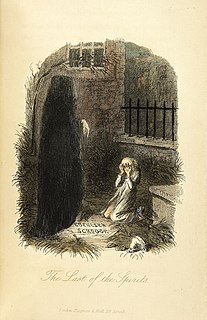
The future is the time after the past and present. Its arrival is considered inevitable due to the existence of time and the laws of physics. Due to the apparent nature of reality and the unavoidability of the future, everything that currently exists and will exist can be categorized as either permanent, meaning that it will exist forever, or temporary, meaning that it will end. In the Occidental view, which uses a linear conception of time, the future is the portion of the projected timeline that is anticipated to occur. In special relativity, the future is considered absolute future, or the future light cone.

Back to the Future Part III is a 1990 American science fiction Western film and the final installment of the Back to the Future trilogy. The film was directed by Robert Zemeckis, and stars Michael J. Fox, Christopher Lloyd, Mary Steenburgen, Thomas F. Wilson and Lea Thompson. The film continues immediately following Back to the Future Part II (1989); while stranded in 1955 during his time travel adventures, Marty McFly (Fox) discovers that his friend Dr. Emmett "Doc" Brown (Lloyd), trapped in 1885, was killed by Buford "Mad Dog" Tannen (Wilson), Biff's great-grandfather. Marty travels to 1885 to rescue Doc and return once again to 1985, but matters are complicated when Doc falls in love with Clara Clayton (Steenburgen).

St Katharine Docks is a former dock and now a mixed-used district in Central London, in the London Borough of Tower Hamlets and within the East End. It lies on the north bank of the River Thames, immediately downstream of the Tower of London and Tower Bridge. From 1828 to 1968, it was one of the commercial docks that made up the Port of London. It is in the redevelopment zone known as Docklands and is now a popular housing and leisure complex.

Waterloo Bridge is a road and foot traffic bridge crossing the River Thames in London, between Blackfriars Bridge and Hungerford Bridge and Golden Jubilee Bridges. Its name commemorates the victory of the British, Dutch and Prussians at the Battle of Waterloo in 1815. Thanks to its location at a strategic bend in the river, the bridge offers good views of Westminster, the South Bank and the London Eye to the west, and of the City of London and Canary Wharf to the east.

In theoretical physics, a Penrose diagram is a two-dimensional diagram capturing the causal relations between different points in spacetime through a conformal treatment of infinity. It is an extension of a Minkowski diagram where the vertical dimension represents time, and the horizontal dimension represents a space dimension. Using this design, all light rays take a 45° path.. The biggest difference is that locally, the metric on a Penrose diagram is conformally equivalent to the actual metric in spacetime. The conformal factor is chosen such that the entire infinite spacetime is transformed into a Penrose diagram of finite size, with infinity on the boundary of the diagram. For spherically symmetric spacetimes, every point in the Penrose diagram corresponds to a 2-dimensional sphere .
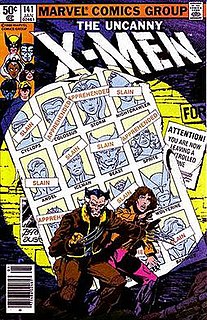
"Days of Future Past" is a storyline in the Marvel Comics comic book The Uncanny X-Men issues #141–142, published in 1981. It deals with a dystopian future in which mutants are incarcerated in internment camps. An adult Kate Pryde transfers her mind into her younger self, the present-day Kitty Pryde, who brings the X-Men to prevent a fatal moment in history that triggers anti-mutant hysteria.
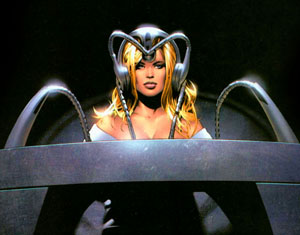
Cerebro is a fictional device appearing in American comic books published by Marvel Comics. The device is used by the X-Men to detect humans, specifically mutants. It was created by Professor X and Magneto, and was later enhanced by Dr. Hank McCoy.

Brave is a 1994 musical film directed by Richard Stanley and based on the 1994 concept album Brave by English progressive rock band Marillion.
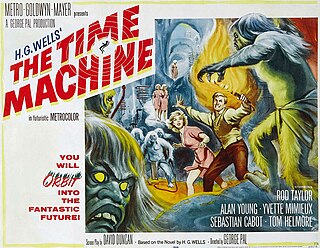
Time travel is a common theme in fiction, mainly since the late 19th century, and has been depicted in a variety of media, such as literature, television, film, and advertisements.

"Meet the Quagmires" is the 18th and final episode of the fifth season of the animated comedy series Family Guy. It originally aired on Fox on May 20, 2007. The episode features Peter after he goes back in time, in order to live the single life a little longer, before he meets future wife Lois. This causes Quagmire to make his own move on Lois, and they ultimately end up marrying and having children; Peter is horrified by this "alternate timeline" and resolves to go back in time again and set things right.

"Living Dead Girl" is the second single from Rob Zombie's solo debut album Hellbilly Deluxe. The line, "Who is this irresistible creature who has an insatiable love for the dead?" in the beginning of the song is from the trailer of the film Lady Frankenstein. The music in the beginning of the song is taken from the trailer of the Wes Craven film, The Last House on the Left. The spoken words "What are you thinking about?/The same thing you are" at the beginning of the verses are taken from the 1971 film Daughters of Darkness. In this song, Zombie sings, "Goldfoot's machine creates another friend so beautiful they make you kill". This relates to the villain played by Vincent Price in the 1965 film Dr. Goldfoot and the Bikini Machine and the 1966 film Dr. Goldfoot and the Girl Bombs. Also, he sings "Operation Filth they love to love the wealth of an SS making scary sounds." This is possibly a reference to the notorious 1974 film Ilsa: She-Wolf of the SS.

"The Bridge" is a song from English musician Elton John's 2006 album The Captain & the Kid. It is a simple, stripped-down production focused on John and his piano, with sparse further accompaniment. This is the first song since the title track of Breaking Hearts with this arrangement. The song, which was only released as a promotional single, peaked at No. 19 on Billboard's Hot Adult Contemporary Tracks.
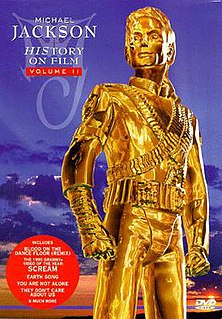
HIStory on Film, Volume II is a collection of music videos by Michael Jackson released by Warner Music Video Enterprises in May 1997. It contains the music videos belonging to Jackson's ninth studio album and first remix album, as well as content featured in Jackson's previous video collection, including "Thriller" and "Beat It".

Tech-noir is a hybrid genre of fiction, particularly film, combining film noir and science fiction, epitomized by Ridley Scott's Blade Runner (1982) and James Cameron's The Terminator (1984). The tech-noir presents "technology as a destructive and dystopian force that threatens every aspect of our reality."
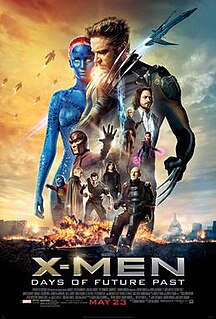
X-Men: Days of Future Past is a 2014 American superhero film directed and produced by Bryan Singer and written by Simon Kinberg from a story by Kinberg, Jane Goldman, and Matthew Vaughn. The film is based on the fictional X-Men characters that appear in Marvel Comics, the fifth mainline installment of the X-Men film series, a sequel to X-Men: The Last Stand (2006) and X-Men: First Class (2011), a follow-up to The Wolverine (2013), and the seventh installment overall. It stars an ensemble cast, including Hugh Jackman, James McAvoy, Michael Fassbender, Jennifer Lawrence, Halle Berry, Anna Paquin, Elliot Page, Peter Dinklage, Ian McKellen, and Patrick Stewart. The story, inspired by the 1981 Uncanny X-Men storyline "Days of Future Past" by Chris Claremont and John Byrne, focuses on two time periods, with Logan traveling back in time to 1973 to change history and prevent an event that results in unspeakable destruction for both humans and mutants.

Regular Show: The Movie is a 2015 American animated science fiction comedy film based on animated series, Regular Show. It was produced by Cartoon Network Studios. The film was directed by J. G. Quintel and it features the voices of William Salyers, Quintel, Sam Marin, and Mark Hamill reprising their respective roles from the series, with Jason Mantzoukas and David Koechner joining the cast. The movie follows Mordecai and Rigby, along with their groundskeeping co-workers, Benson, Pops, Muscle Man, Hi-Five Ghost, and Skips, as they embark on a mission to save the universe, and their friendship, from a volleyball coach.

The Future of Work and Death is a 2016 documentary by Sean Blacknell and Wayne Walsh about the growth of exponential technology.



















